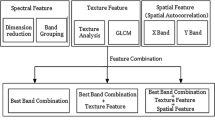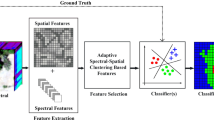Abstract
The methods based on processing video data have shown their efficiency in many areas of agriculture and forestry. Nevertheless, they are not enough accurate for classification of barely discernible objects and types of plants, which can be provided only using hyperspectral sensors. However, such devices by now were expensive and difficult in operation and were used mostly on satellites and manned aircraft. In recent years, the technologies for creating smaller and lighter sensors have been proposed; these technologies are based on the choice of restricted number of spectral intervals and their position at the design stage. They may be used for scientific or commercial goals under field conditions and, in addition, installed on unmanned aerial vehicles. Exemplified by a 220-channel hyperspectral image, this paper investigates the capability of significant reduction in the amount of registered data due to choice of position and width of restricted number of most informative spectral channels in solving the classification problem of agricultural plants. It is shown that the applied method for generating feature systems has a considerable advantage against the regular decimation and is close in its efficiency to the methods based on the analysis of principal components, but has a significantly less amount of needed computations.


Similar content being viewed by others
REFERENCES
Perspective Information Technologies of Earth’s Remote Sensing, Ed. by V. A. Soifer (Novaya Tekhnika, Samara, 2015).
V. G. Bondur, ‘‘Modern approaches to processing large hyperspectral and multispectral aerospace data flows,’’ Izv., Atmos. Ocean. Phys. 50, 840–852 (2014). https://doi.org/10.1134/S0001433814090060
V. V. Shipko, ‘‘Noise filtration in hyperspectral images,’’ Optoelectron., Instrum. Data Process. 56, 19–27 (2020). https://doi.org/10.3103/S8756699020010033
V. V. Kozoderov, T. V. Kondranin, and E. V. Dmitriev, ‘‘Recognition of natural and man-made objects in airborne hyperspectral images,’’ Izv., Atmos. Ocean. Phys. 50, 878–886 (2014). https://doi.org/10.1134/S0001433814090126
A. N. Vinogradov, V. V. Egorov, A. P. Kalinin, E. M. Melnikova, and A. I. Rodionov, ‘‘The set of hyperspectral sensors in the optical band,’’ Preprint No. Pr-2176, IKI RAN (Space Research Institute, Russian Academy of Sciences, 2015).
N. Tack, A. Lambrechts, S. Soussan, and L. Haspeslagh, ‘‘A compact, high-speed, and low-cost hyperspectral imager,’’ Proc. SPIE 8266, 82660Q (2012). https://doi.org/10.1117/12.908172
B. Geelen, N. Tack, and A. Lambrechts, ‘‘A snapshot multispectral imager with integrated, tiled filters and optical duplication,’’ Proc. SPIE 8613, 861314 (2013). https://doi.org/10.1117/12.2004072
N. Gat, ‘‘Imaging spectroscopy using tunable filters: a review,’’ Proc. SPIE 4056, 50–64 (2000). https://doi.org/10.1117/12.381686
J. H. Correia, M. Bartek, and R. F. Wolffenbuttel, ‘‘High-selectivity single-chip spectrometer in silicon for operation in visible part of the spectrum,’’ IEEE Trans. Electron Devices 47, 553–559 (2000). https://doi.org/10.1109/16.824727
M. Jayapala, A. Lambrechts, N. Tack, B. Geelen, B. Masschelein, and P. Soussan, ‘‘Monolithic integration of flexible spectral filters with CMOS image sensors at wafer level for low cost hyperspectral imaging. http://www.imagesensors.org/Past%20Workshops/2013%20Workshop/2013%20Papers/07-02_053-jayapala.pdf. Cited May 15, 2020.
A. Shvedov, ‘‘Hyperspectral sensors of IMEC company. Solutions for high-quality spectral analysis.’’ https://www.npk-photonica.ru/giperspektralnye-sensory-kompanii-imec-pdf163406.pdf. Cited May 15, 2020.
R. V. Skidanov, A. A. Morozov, A. P. Porfirev, and V. A. Blank, ‘‘An imaging spectrometer based on a discrete interference filter,’’ Comput. Opt. 39, 716–720 (2015). https://doi.org/10.18287/0134-2452-2015-39-5-716-720.
S. M. Borzov, M. A. Guryanov, and O. I. Potaturkin, ‘‘Study of the classification efficiency of difficult-to-distinguish vegetation types using hyperspectral data,’’ Comput. Opt. 43, 464–473 (2019). https://doi.org/10.18287/2412-6179-2019-43-3-464-473.
S. M. Borzov, A. O. Potaturkin, O. I. Potaturkin, and A. M. Fedotov, ‘‘Analysis of the efficiency of classification of hyperspectral satellite images of natural and man-made areas,’’ Optoelectron., Instrum. Data Process. 52, 1–10 (2016). https://doi.org/10.3103/S8756699016010015
S. M. Borzov and O. I. Potaturkin, ‘‘Efficiency of the spectral-spatial classification of hyperspectral imaging data,’’ Optoelectron., Instrum. Data Process. 53, 26–34 (2017). https://doi.org/10.3103/S8756699017010058
I. Fodor, ‘‘A survey of dimension reduction techniques,’’ Technical Report No. UCRL-ID-148494 (Univ. California, Oakland, 2002).
I. A. Pestunov and P. V. Melnikov, ‘‘Principal component analysis and its modifications in hyperspectral image classification,’’ Interexpo Geo-Siberia 4 (2), 45–50 (2015).
M. F. Baumgardner, L. L. Biehl, and D. A. Landgrebe, ‘‘220 band AVIRIS hyperspectral image data set: June 12, 1992 Indian Pine test site 3,’’ (Purdue Univ. Research Repository, 2015). https://doi.org/10.4231/R7RX991C.
T. Merill and D. Green, ‘‘On the effectiveness of receptors in recognition systems,’’ IEEE Trans. Inf. Theory JT, 11–17 (1963). https://doi.org/10.1109/TIT.1963.1057810
P. Ghamisi and J. A. Benediktsson, ‘‘Feature selection based on hybridization of genetic algorithm and particle swarm optimization,’’ IEEE Geosci. Remote Sens. Lett. 12, 309–313 (2015). https://doi.org/10.1109/LGRS.2014.2337320
D. Beasley, D. R. Bull, and R. R. Martin, ‘‘An overview of genetic algorithms,’’ Univ. Comput. 15 (2), 58–69 (1993).
Yu. L. Barabash, B. V. Varskii, V. T. Zinoviev, et al., Automatic Image Recognition (KVAIU, Kiev, 1964).
J. A. Richards, Remote Sensing Digital Image Analysis (Springer-Verlag, Berlin, 1999).
N. Cristianini and J. Shawe-Taylor, An Introduction to Support Vector Machines and Other Kernel-Based Learning Methods (Cambridge Univ. Press, Cambridge, 2000). https://doi.org/10.1017/CBO9780511801389
C.-C. Chang and C.-J. Lin, ‘‘LIBSVM: A library for support vector machines,’’ ACM Trans. Intell. Syst. Technol. 2, 27 (2011). https://doi.org/10.1145/1961189.1961199
N. G. Zagoruiko, V. N. Elkina, G. S. Lbov, and S. V. Emel’yanov, Package of Applied Programs OTEKS (Finansy i Statistika, Moscow, 1986).
V. N. Elkina, N. G. Zagoruiko, and V. S. Temirkaev, ‘‘Algorithms of directed taxonomic search of informative subsystems of features (DTSA),’’ Vychislit. Syst. Sb. IM SO AN SSSR 59, 49–70 (1974).
Remote Sensing: Qualitative Approach, Ed. by A. S. Alekseev (Nedra, Moscow, 1983).
O. A. Dubrovskaya, T. A. Gurova, and I. A. Pestunov, ‘‘Disease detection on wheat plantings by data of hyperspectral monitoring,’’ in Proc. Int. Conf. Spatial Data Processing Monitoring Prob. Nat. and Human-Made Processes (SDM-2019), Novosibirsk, 2019, pp. 497–500.
A. A. Green, M. Berman, P. Switzer, and M. D. Craig, ‘‘A transformation for ordering multispectral data in terms of image quality with implications for noise removal,’’ IEEE Trans. Geosci. Remote Sens. 26, 65–74 (1988). https://doi.org/10.1109/36.3001
Author information
Authors and Affiliations
Corresponding authors
Additional information
Translated by E. Oborin
About this article
Cite this article
Borzov, S.M., Potaturkin, O.I. Selection of the Informative Feature System for Crops Classification Using Hyperspectral Data. Optoelectron.Instrument.Proc. 56, 431–439 (2020). https://doi.org/10.3103/S8756699020040032
Received:
Revised:
Accepted:
Published:
Issue Date:
DOI: https://doi.org/10.3103/S8756699020040032




